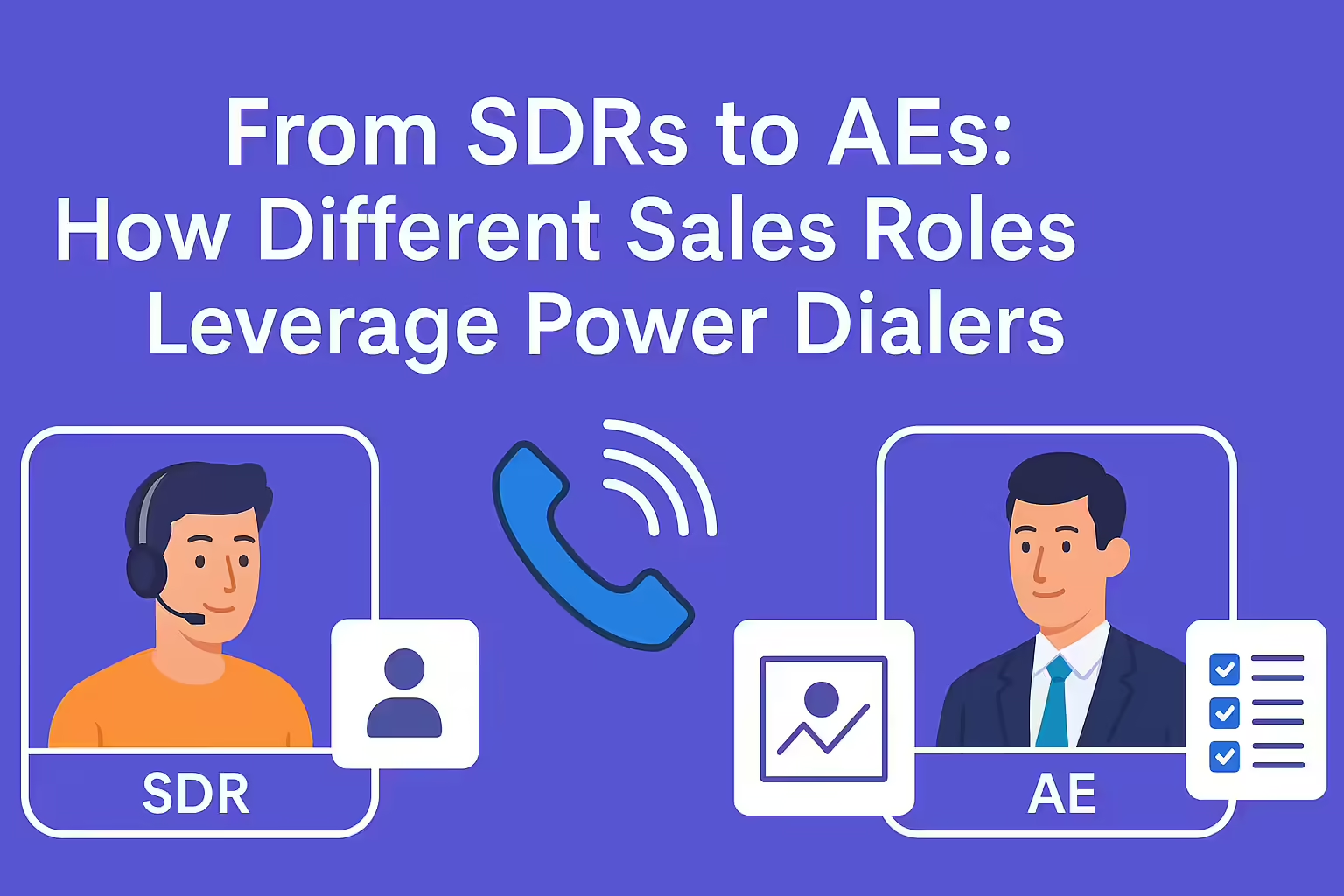Power Dialer for SDRs and AEs: How Different Sales Roles Use the Same Technology
Maximizing efficiency at every stage of the sales cycle with specialized processes for Sales Development Representatives and Account Executives
In the relentless pursuit of revenue, modern sales organizations operate at a demanding pace. Success hinges on maximizing efficiency at every stage of the sales cycle, from the first spark of outreach to the final handshake on a closed deal. Driving this process are two pivotal roles:
- Sales Development Representatives (SDRs), who initiate conversations, qualify leads, and hand them off to …
- Account Executives (AEs), who guide those opportunities to a successful close.
The Sales Team Structure: Defining SDRs and AEs
The Sales Development Representative (SDR)
SDRs operate primarily at the top of the sales funnel as the first point of contact. Their responsibilities include:- Prospecting and Research: Identifying companies and individuals matching the Ideal Customer Profile (ICP).
- High-Volume Outreach: Cold calling, emailing, and social selling at scale to locate viable leads efficiently.
- Lead Qualification: Quickly assessing whether a lead’s interest and needs align with the product or service.
- Appointment Setting: Transitioning qualified leads to the appropriate AE for deeper discussions and potential demos.
The Account Executive (AE)
Once leads are qualified, AEs take over. Their duties involve:- Discovery and Demonstration: Conducting in-depth discovery calls and tailored product demos.
- Solution Crafting: Presenting proposals and matching solutions precisely to prospect needs.
- Relationship Building: Establishing trust with decision-makers, often requiring multiple touches across various channels.
- Closing and Negotiation: Addressing objections, negotiating contract terms, and sealing the deal.
Decoding the Power Dialer: More Than Just Auto-Dialing
A power dialer automates outbound calling by dialing numbers in quick succession. Once a call ends, the system automatically moves to the next contact—significantly reducing idle time. Modern power dialers, however, do far more than just speed-dial:- CRM Integration: Automatically pulls in lead records and logs call outcomes back into the CRM.
- Voicemail Drop: Lets reps leave a pre-recorded message with a single click.
- Local Presence Dialing: Increases pickup rates by matching the area code displayed on the recipient’s caller ID.
- Call Dispositions and Analytics: Tracks call outcomes, conversation lengths, follow-up tasks, and other performance metrics.
The SDR Playbook: High-Volume Outreach With Power Dialers
Because SDRs rely on connecting with as many potential leads as possible, a power dialer supports:- High-Speed Dialing: Rapidly call through large lists, maximizing daily outbound attempts.
- Automation: Minimize busywork through voicemail drop, automated logging, and click-to-call.
- Connection-Rate Boosters: Features like local presence dialing and spam protection help ensure more prospects pick up.
For SDRs: Supercharging Initial Outreach with Power Dialers
While the general principles above apply to all SDR teams, Kixie adds specialized functionality to help them go even further:1. Instant Contact with New Leads
Speed-to-lead is critical. Power dialers allow SDRs to call fresh leads the moment they appear in the CRM. Automated workflows in platforms like HighLevel can trigger a call the instant a new contact is created.2. Efficient Prospecting with PowerLists
SDRs can systematically dial large lists of cold leads uploaded via CSV or synced from the CRM. With Kixie’s ability to dial up to 10 numbers simultaneously, the rep is patched through to the first contact who answers while other calls disconnect automatically.3. Prioritized Outreach
SDRs can focus on warm, promising segments first by ranking PowerLists. Hotter prospects at the top of the list receive immediate attention, fueling better conversion rates.4. Boosting Connection Rates
Kixie’s “Connection Boost” bundles local presence dialing, AI spam protection, and rotating caller IDs to significantly increase the likelihood of a prospect answering.5. Automated Follow-up for Missed Connections
Missed calls can trigger automatic SMS follow-ups or initiate another call attempt using a different local number. SDRs can also rely on a shared “team SMS” number for immediate, personalized text outreach—offering a gentler first touch.The AE Strategy: Nurturing Deals with Power Dialers
AEs, inheriting the qualified leads from SDRs, rely on the power dialer for targeted efficiency. Rather than blasting through lists, they use it to:- Maintain Momentum: A structured follow-up process ensures opportunities don’t stall.
- Leverage CRM Data: Deep integration pulls essential deal details and past interactions into view, enabling more personalized conversations.
- Multi-Channel Follow-Up: Quickly pivot between calls, texts, and emails to keep the deal moving.
- Task Scheduling: Automatic reminders and tasks (synced with the CRM) help AEs never miss a critical follow-up.
For AEs: Streamlining Follow-Up and Engagement with Power Dialers
Kixie’s power dialer further addresses the AE’s need for contextual, high-quality engagement:1. Structured Follow-up with PowerLists
Create PowerLists for deals needing attention (e.g., prospects who’ve seen demos or proposals) so AEs can methodically make their next calls.2. Triggered Follow-ups Based on Engagement
If a prospect opens a proposal, finishes reading a document, or performs any key engagement, an automated alert can prompt a timely outreach call or text.3. Efficient Call Scheduling and Task Management
When an AE connects but needs to follow up later, they can log a callback task right within the dialer. Data like the contact ID syncs via webhook for additional automations, such as calendar invites.4. Contextual Conversations with CRM Integration
Kixie’s dialer surfaces critical details—previous call notes, deal stage, goals submitted on a form—before each call. “Next Call Refresher” helps AEs remember and reference vital points instantly.5. Automated Post-Call Actions
Call outcomes automatically trigger CRM updates, schedule follow-ups, or send personalized emails. This keeps the deal flowing without tedious manual admin.6. Tracking Call History and Outcomes
AEs can review comprehensive call histories in both Kixie and the CRM, preserving conversation details and gleaning insights for future touchpoints.Complementary Power Dialer Features for Both SDRs and AEs
While SDRs and AEs each approach power dialers differently, there are many overlapping capabilities that benefit both roles:- Customizable Call Outcomes — Configure outcomes that match your CRM stages, which then trigger the correct follow-up sequences and reporting metrics.
- Voicemail Drops and SMS Templates — Pre-record a consistent voicemail message or create standardized SMS templates; reps can quickly personalize these with CRM data for each contact.
- Seamless CRM and Tool Integration — Kixie integrates with popular CRMs like HighLevel, HubSpot, Salesforce, Pipedrive, and Zoho. Webhooks can stream data into Slack for notifications, track marketing sources, automate Zendesk ticket creation, or even send eGift cards through Sendoso.
- Call Recording and Monitoring — Managers can listen to calls live, whisper advice to agents, or even join conversations (barge) for coaching or deal support.
- Call Attempts & Follow-up Logic — With features like the “Kixie Call Counter,” track how many times a lead has been called and trigger next-step automations after a certain threshold.
- Actionable Power Dialer Analytics — Access real-time dashboards to monitor agent activity, outcomes, and speed-to-lead metrics—great for identifying coaching opportunities and performance trends.
- Efficient PowerList Management — Automatically remove contacts from lists once they convert or change status, preventing repetitive calls to the same person.
Kixie in Focus: Tailored Power Dialing for Every Sales Role
Empowering SDRs
- High-Volume Dialing: Multi-line dialing supports up to 10 simultaneous call attempts.
- AI Human Voice Detection: Connects SDRs directly to live prospects by filtering out IVRs or voicemail systems, saving time.
- One-Click Automations: Voicemail drop, automated SMS, and local presence all reduce friction so SDRs can focus on live conversations.
Supporting AEs
- Deep Bi-Directional CRM Integration: Everything—calls, texts, dispositions—logs back into HubSpot, Salesforce, or another CRM automatically.
- Context-Driven Click-to-Call: AEs can call directly from the CRM record, review notes, and reference deal stage info before dialing.
- Post-Call Triggers: Automatically update deal stages, schedule tasks, or send custom emails the moment a call disposition is saved.
Kixie’s focus on intelligent efficiency—combining fast dialing with robust integrations and AI-backed connection optimizations—ensures both SDRs and AEs see greater productivity and more meaningful interactions.
Conclusion: Dialing In on Sales Success
A power dialer is far more than a rapid-fire calling tool; when used strategically according to each role’s goals, it becomes a fundamental driver of growth. SDRs harness it to tackle high volumes of outreach, filtering through potential leads at lightning speed. AEs rely on its deep CRM integration and automated workflows to nurture relationships, build trust, and close deals faster. Kixie exemplifies how modern platforms blend multi-line dialing, AI-driven features like spam protection or local presence, and seamless CRM synchronization to meet these diverse needs. By uniting speed and context, Kixie’s Power Dialer and ConnectionBoost technology help sales teams:- Reach More Prospects (SDRs can skyrocket call volume without compromising quality).
- Stay Organized and Informed (AEs see every previous interaction at a glance).
- Automate Tedious Tasks (Freeing reps at all levels to focus on live conversations).



